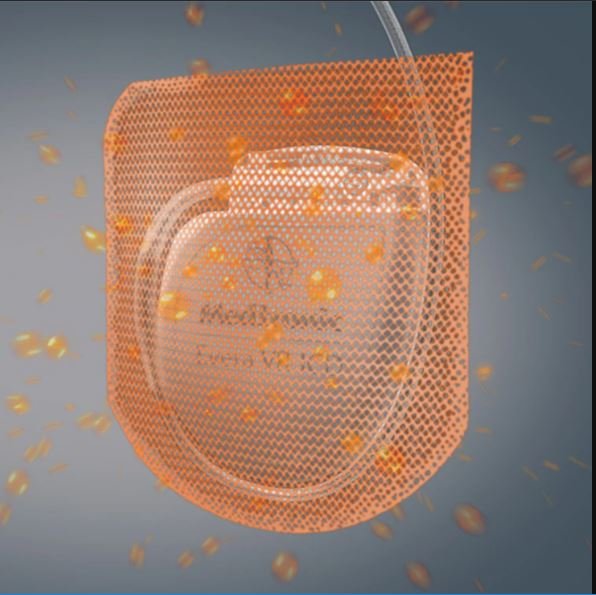DUBLIN, Sept. 16, 2020 /PRNewswire/ — Medtronic plc (NYSE: MDT), the global leader in medical technology announced new data from the landmark WRAP-IT study, showing the TYRX™ Absorbable Antibacterial Envelope (TYRX Envelope) is cost effective for patients at increased risk of infections who receive cardiac implantable electronic devices (CIEDs). The analysis, newly published in Circulation: Arrhythmia and Electrophysiology, demonstrates the envelope’s cost-effectiveness compared to standard-of-care infection prevention strategies in the U.S. healthcare system.
Cost-effectiveness analyses are tools to indicate which interventions provide good value for money.1 This pre-specified analysis of the global WRAP-IT Trial (Worldwide Randomized Antibiotic Envelope Infection Trial) compared costs and patient outcomes between patients who received the TYRX Envelope and patients who received standard-of-care. The TYRX Envelope is cost-effective in the WRAP-IT patient population, with its ICER (incremental cost effectiveness ratio*) well below the upper willingness to pay threshold of $150,000, the recommended threshold of the American College of Cardiology/American Heart Association practice guidelines on cost/value methodology.2

“This analysis builds upon the results of the landmark WRAP-IT study, which showed use of the antibiotic envelope results in a significant reduction in infections, with no increase in complications,” said Bruce Wilkoff, M.D., director of Cardiac Pacing and Tachyarrhythmia Devices at Cleveland Clinic, lead author and a paid consultant to Medtronic. “These new data provide evidence that the envelope improves patient outcomes in a cost-efficient way.”
“We are committed to identifying and creating cost-effective innovations like the TYRX Envelope that add value by reducing readmission rates, lowering infection risk, and decreasing hospitalizations,” said Rob Kowal, M.D., Ph.D., chief medical officer of the Cardiac Rhythm and Heart Failure division, which is part of the Cardiac and Vascular Group at Medtronic. “During a global pandemic, reducing infections and readmissions is especially important because it means patients have fewer needs for supplemental medical care, which reduces the risk of exposure for themselves and their clinicians.”
Additional Study Results Published
Long-term results from WRAP-IT, recently published in Heart Rhythm, show that the effects of TYRX to reduce major CIED infection were sustained through three years of follow-up, which was driven by a significant reduction in pocket infections.3
Further, “impact of infection” data from the study, also published in Circulation: Arrhythmia and Electrophysiology, showed that patients who experience a major CIED infection are at a greater than threefold risk of death at one year compared to patients without an infection;4 experience an additional 9-18 days in the hospital;4,5 suffer impaired quality of life through six months;4 and pay approximately $2,000 in out-of-pocket costs to treat the infection.4 TYRX is the only intervention shown to significantly reduce CIED infection in addition to standard-of-care pre-operative antibiotics.
Importantly, based on the WRAP-IT results, an international consensus statement, supported by seven medical societies (including the Heart Rhythm Society) recommends TYRX for the WRAP-IT study population and for patients with high risk factors.6
Cleveland Clinic named the Medtronic TYRX Envelope one of the Top 10 Medical Innovations for 2020.7
About the WRAP-IT Clinical Trial
WRAP-IT compared the incidence of major infections in 6,983 patients whose CIED implantation included the TYRX Envelope (3,495) and patients whose procedure did not (3,488), with follow up through 12 months. Primary results published in The New England Journal of Medicine demonstrated the TYRX Envelope reduced the risk of major infection by 40% in patients with CIEDs and reduced pocket infections by 61%, compared to standard of care pre-operative antibiotics8 The trial also met its safety objective: the envelope did not increase the risk of complications through 12 months.
The study population included patients receiving a new cardiac resynchronization therapy defibrillator (CRT-D); and patients receiving a replacement, system revision or generator upgrade of an existing pacemaker, cardiac resynchronization therapy-pacemaker (CRT-P), implantable cardioverter defibrillator (ICD) or CRT-D. Patients with diabetes, previous history of infection, renal failure, and/or congestive heart failure also are at higher risk for CIED infections.
About the TYRX™ Absorbable Antibacterial Envelope
The TYRX Envelope is an absorbable single-use device that holds a cardiac implantable electronic device or implanted neurostimulator. It is designed to stabilize the device after implantation while releasing antimicrobial agents, minocycline and rifampin, over a minimum of seven days.9 Constructed from a multifilament, knitted absorbable mesh, the envelope is fully absorbed by the body approximately nine weeks after implantation.9,10 The device has a one-year shelf life in the U.S., Canada, Australia and New Zealand.
In collaboration with leading clinicians, researchers and scientists worldwide, Medtronic offers the broadest range of innovative medical technology for the interventional and surgical treatment of cardiovascular disease and cardiac arrhythmias. The company strives to offer products and services of the highest quality that deliver clinical and economic value to healthcare consumers and providers around the world.
About Medtronic
Medtronic plc (www.medtronic.com), headquartered in Dublin, Ireland, is among the world’s largest medical technology, services and solutions companies – alleviating pain, restoring health and extending life for millions of people around the world. Medtronic employs more than 90,000 people worldwide, serving physicians, hospitals and patients in more than 150 countries. The company is focused on collaborating with stakeholders around the world to take healthcare Further, Together.
Any forward-looking statements are subject to risks and uncertainties such as those described in Medtronic’s periodic reports on file with the Securities and Exchange Commission. Actual results may differ materially from anticipated results.
* ICER is a statistical summary of a healthcare intervention’s cost effectiveness.
1 World Health Organization. Website – Cost effectiveness and strategic planning (WHO-CHOICE). Accessed May 1, 2020. https://www.who.int/choice/description/importance/en/
2 Anderson JL, et al. ACC/AHA Statement on Cost/Value Methodology in Clinical Practice Guidelines and Performance Measures. Circulation. 2014;129:2329-2345.
3 Mittal S et al. Heart Rhythm. 2020 Jul;17(7):1115-1122
4 Wilkoff BL, et al. Impact of Cardiac Implantable Electronic Device Infection: A Clinical and Economic Analysis of the WRAP-IT Trial. Circ ArrhythmElectrophysiol. https://doi.org/10.1161/CIRCEP.119.008280
5 Sohail MR, et al. Arch Intern Med. 2011;171:1821-8.
6 Blomström-Lundqvist C, et al. European Heart Rhythm Association (EHRA) international consensus document on how to prevent, diagnose, and treat cardiac implantable electronic device infections – endorsed by the Heart Rhythm Society (HRS), the Asia Pacific Heart Rhythm Society (APHRS), the Latin American Heart Rhythm Society (LAHRS), International Society for Cardiovascular Infectious Diseases (ISCVID) and the European Society of Clinical Microbiology and Infectious Diseases (ESCMID) in collaboration with the European Association for Cardio-Thoracic Surgery (EACTS). EP Europace. 2020 April;22(4) https://doi.org/10.1093/europace/euz246
7 Cleveland Clinic Unveils Top 10 Medical Innovations for 2020. https://innovations.clevelandclinic.org/Summit/Top-10-Medical-Innovations/Top-10-for-2020. Downloaded July 10,2020.
8 Tarakji KG, et al. Antibacterial Envelope to Prevent Cardiac Implantable Device Infection. NEJM. DOI: 10.1056/NEJMoa1901111
9 Huntingdon Life Sciences Study TR-2013-001.
10 Sinclair Labs Study D13599.












